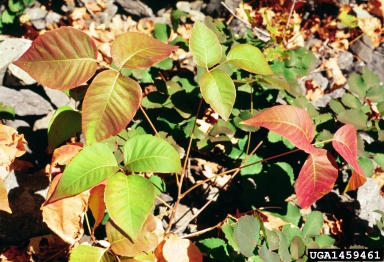Poison Ivy
Toxicodendron radicans
Family: Anacardiaceae
Natural History

Fall colors of poison ivy
Photo credit: Steve Dewey, Utah State University, Bugwood.org
Poison ivy grows on a wide range of habitats, from moist and shady to open and dry. Poison ivy is found in most of the southeast, between Arizona and Florida in the south, to Nebraska and Canada in the north.
ivy sap causes an allergic reaction in humans. The active agent is secreted from broken resin ducts. Most plant parts contain a chemical that causes itching, swelling, rashes, and blisters.
Plants are variously poisonous depending on the time of year and plant maturity, and people vary in susceptibility. In winter, theplant is leafless and dead looking but is actually alive and still very toxic.
Animals are generally not susceptible to the toxic chemical in poison ivy. A wide variety of birds consume the fruits. The leaves and fruits are some of the most important foods of white-tailed deer. The sap is used to make indelible ink and the plant is used to prevent erosion on sand dunes due to its tough root system.
Poison ivy grows straight up a tree without winding around it. Poison oak (Toxicodendron pubescens) is similar but only grows as a shrub up to 3' tall, usually in drier soils than poison ivy. Poison oak leaves have more wavy margins than poison ivy.
